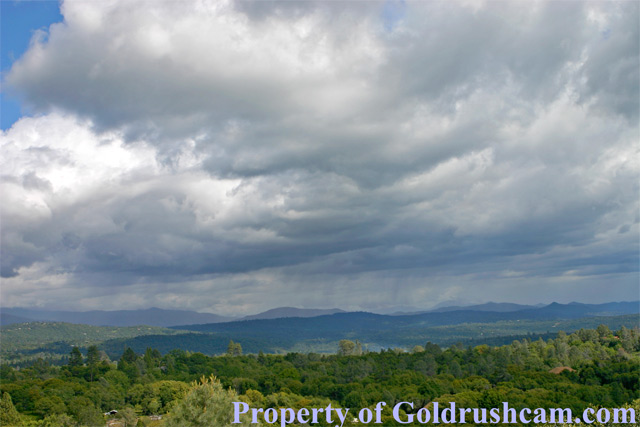
Rain clouds over Mariposa County
Sierra Sun Times file photo
October 7, 2020 - By Christine Souza - The 2021 water year begins with farmers concerned about dry months ahead.
Despite little precipitation and a small snowpack in the 2020 water year, which ended Sept. 30, California weathered the year on water stored in reservoirs during previous years' storms. Going into 2021, farmers note that weather  officials predict a La Niña climate pattern in the Pacific Ocean, which has brought drought conditions in the past.
officials predict a La Niña climate pattern in the Pacific Ocean, which has brought drought conditions in the past.
"We are concerned going into next year, since this is looking like maybe we're going into a 2014-type (drought) year unless we get some good rains," said Glenn County farmer Jim Jones, a director on the Orland-Artois Water District and the Tehama-Colusa Canal Water Authority. "It behooves us to build more water storage here in California. It would've been nice if we'd already had it; we could have caught those rains last year and it would definitely alleviate all the fears going into this coming year."
Good reservoir storage from a wet 2019 tempered the impact of dry weather in 2020. The California Department of Water Resources reported statewide reservoir storage at the end of September stood at 93% of average, or 21.5 million-acre feet. But reservoirs received just a third of the water runoff from precipitation and snowmelt that they did during the same period a year earlier.
"We had an above-average year in 2019 that led to the fifth-best snowpack in California history, but then January and February came in and it was the driest February on record," DWR public information officer Chris Orrock said.
Fresno County farmer Joe Allen, who grows cantaloupes, wheat and cotton near Firebaugh and farms in the Westlands Water District, said "pretty decent carryover" from the prior year gave farmers "a little bit of water to work with."
Westlands, a federal contractor through the Central Valley Project, received a 20% water allocation this year from the U.S. Bureau of Reclamation.
Allen called the 20% allocation "somewhat disappointing."
"That really changed our thinking of what we were going to grow, and we did fallow a couple of blocks," he said. "When the allocation is 20% or less, that's when we have to take a hard look and try to figure out what we're going to do as far as making our operation profitable."
California Farm Bureau Federation Senior Counsel Chris Scheuring said the state's water delivery system is designed to ride out dry years, but has become increasingly less able to do so because of changing hydrology and regulatory constraints that often lead to legal action.
In 2020, a legal struggle erupted over management of water in the Sacramento-San Joaquin river system. Environmental groups and the state of California challenged biological opinions issued in 2019 by federal fisheries agencies for long-term operations of the CVP and State Water Project, seeking a return to previous biological opinions and possible reductions in water deliveries, pending final resolution of the dispute.
In July, farmers who rely on CVP deliveries earned an initial victory when a federal judge denied environmental groups' request for an injunction that would have required the bureau to reduce water allocations to manage water temperatures in the Sacramento River below Shasta Dam. The groups sought more cold water for spring- and winter-run chinook salmon.
In the coming year, Scheuring predicted "more arguments in court about whether the pumps need to be restricted further."
"When you have the (federal and state) pumps operating at odds with each other, it is not a good situation, especially since the state and federal governments are supposed to operate in a coordinated fashion," he said.
The bureau, Scheuring said, has struggled to deliver project water due to constraints imposed by the Endangered Species Act and other requirements.
That's also been the case in the Klamath Basin along the California-Oregon border, where the executive director of the Klamath Water Users Association, Paul Simmons, described 2020 as a year "we would like to forget—even though we can't."
"The paltry water supply and continued uncertainty translate to the loss of many family farms and damage to all farm operations and rural communities," he said, "not to mention harm to wildlife and prized wildlife refuges."
Klamath Project farmers planned for the 2020 season based on an early allocation of 140,000 acre-feet and said they were "blindsided" in May after the bureau cut the already-short allocation to between 55,000 and 75,000 acre-feet. In September, the agency said it would deliver more water.
Last week, the U.S. House of Representatives passed an amendment to the 2000 Klamath Basin Water Supply Enhancement Act, which will better distribute $10 million in annual funding for drought relief in the Klamath Basin, sending the bill to President Trump.
Regarding the Sustainable Groundwater Management Act, which requires local agencies to achieve groundwater sustainability by 2040 or 2042, Scheuring said, "There are differences of opinion about how to achieve sustainability, but there are a lot of positive ways to mitigate SGMA besides just everybody tightening their belt and sharing the pain."
Kole Upton, a farmer from Chowchilla who serves on the boards of the Chowchilla Water District and Friant Water Authority, said, "Without additional surface water supplies or bringing in some of the water that is going out of the delta, the only solution down here is fallowing land; there's just not enough groundwater.
"Water is a public benefit for everybody," he said. "The leadership now is not forward thinking on getting projects ready for the future."
(Christine Souza is an assistant editor of Ag Alert. She may be contacted at csouza@cfbf.com.)
Reprinted with permission CA. Farm Bureau Federation








